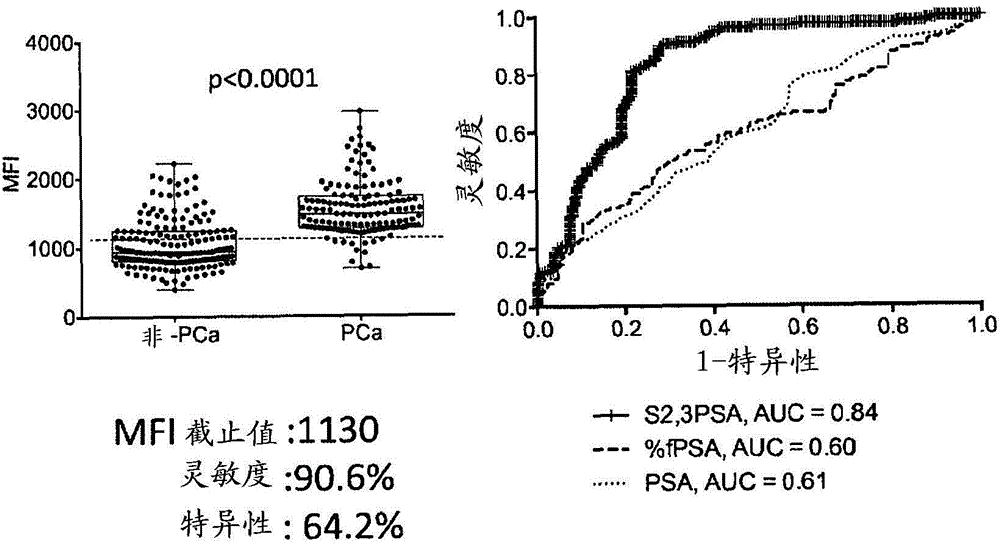Method and kit for distinguishing between prostate carcinoma and benign prostatic hyperplasia
一种前列腺肥大、前列腺癌的技术,应用在仪器、分析材料、测量装置等方向,能够解决品质偏差、需要血清等问题,达到再现性良好的效果
- Summary
- Abstract
- Description
- Claims
- Application Information
AI Technical Summary
Problems solved by technology
Method used
Image
Examples
Embodiment approach
[0031] The method for identifying Pca and BPH of the present invention comprises: contacting a PSA-containing analysis sample with a carrier immobilized with an anti-free PSA antibody, allowing free PSA to bind to the anti-free PSA antibody immobilized on the carrier, and then The free PSA is bound to the carrier of the immobilized anti-free PSA antibody and the monoclonal antibody that specifically recognizes the terminal sialic acid residue and the galactose-bound sugar chain through the α (2,3) bond is contacted, so that the specificity A monoclonal antibody that recognizes a sugar chain in which terminal sialic acid residues are bound to galactose through an α(2,3) bond binds to free PSA bound to an anti-free PSA antibody immobilized on a carrier, and detects terminal sialic acid residues The free PSA amount of the N-type sugar chain bound to galactose through the α(2,3) bond, by comparing the obtained measured amount with the preset cut-off value of Pca and BPH, will be mo...
reference example 1
[0039] [Reference Example 1: Production of HYB4 monoclonal antibody that specifically recognizes sugar chains in which the terminal sialic acid residue is bound to galactose through an α(2,3) bond]
[0040] A monoclonal antibody that specifically recognizes a sugar chain in which a terminal sialic acid residue is bonded to galactose via an α(2,3) bond for use in the recognition of prostate cancer and prostatic hypertrophy according to the present invention was prepared according to the following procedure.
[0041] 【(1) Antigen preparation】
[0042] IV as glycolipid 3 NeuAcnLc 4 Cer (NeuAcα2-3Galβ1-4GlcNAcβ1-3Galβ1-4Glcβ1-1'Cer) was used as an immunogen.
[0043] 【(2) Preparation of hybridoma】
[0044] Make IV 3 NeuAcnLc 4 228 μg of Cer (NeuAcα2-3Galβ1-4GlcNAcβ1-3Galβ1-4Glcβ1-1’Cer) was dissolved in 114 μl of EtOH, after ultrasonic treatment, 1820 μl of PBS was added and heated to 37°C. Thereafter, 568 μl of a solution in which acid-treated Salmonella minnesota (Salmonel...
Embodiment 1
[0047] [Example 1: Recognition of Pca and BPH using HYB4 monoclonal antibody (Part 1)]
[0048] Carry out in the following order.
[0049] [(1) Immobilization of anti-free PSA antibody on carrier]
[0050] Magplex microspheres (Luminex), which are magnetic beads, were used as a carrier, and an anti-free PSA antibody was immobilized on the surface according to the manual of the XMAP antibody coupling kit. Specifically, to a 1.5ml tube add 6.25 x 10 6 Magplex microspheres per 500 μl were placed on a magnetic separator for 2 minutes. After magnetic bead precipitation, the supernatant was aspirated and removed. 500 μl of activation buffer was added to the tube, mixed for 10 seconds, and left to stand on a magnetic separator for 2 minutes. After magnetic bead precipitation, the supernatant was aspirated and removed. Another 400 [mu]l activation buffer was added to the tube and mixed for 10 seconds. Next, 50 μl of sulfo-NHS and 50 μl of EDC solution were added, mixed for 10 se...
PUM
 Login to View More
Login to View More Abstract
Description
Claims
Application Information
 Login to View More
Login to View More - Generate Ideas
- Intellectual Property
- Life Sciences
- Materials
- Tech Scout
- Unparalleled Data Quality
- Higher Quality Content
- 60% Fewer Hallucinations
Browse by: Latest US Patents, China's latest patents, Technical Efficacy Thesaurus, Application Domain, Technology Topic, Popular Technical Reports.
© 2025 PatSnap. All rights reserved.Legal|Privacy policy|Modern Slavery Act Transparency Statement|Sitemap|About US| Contact US: help@patsnap.com



